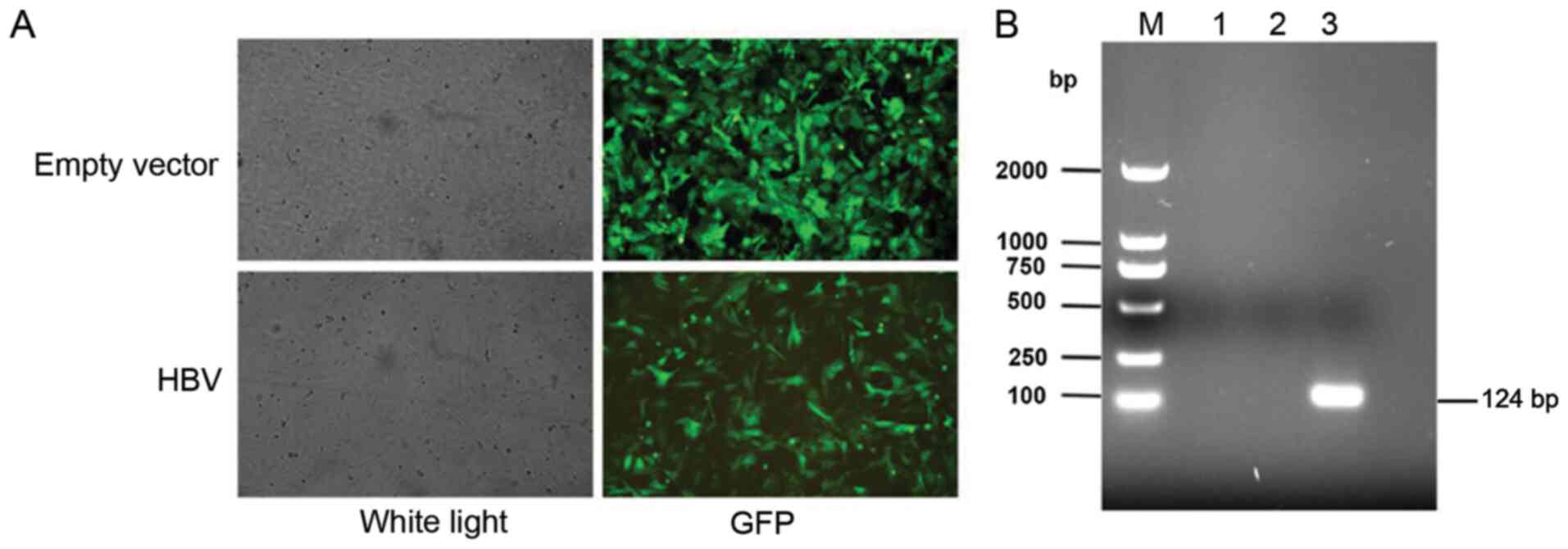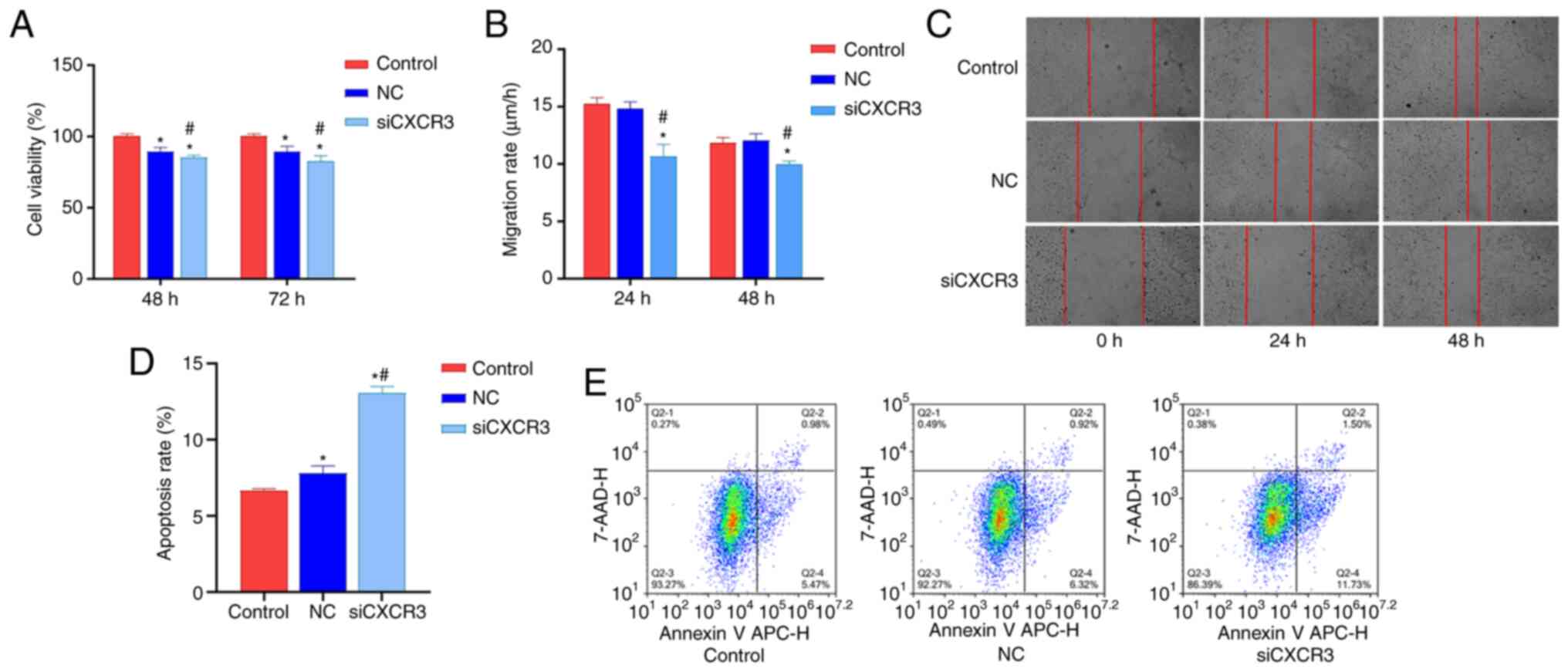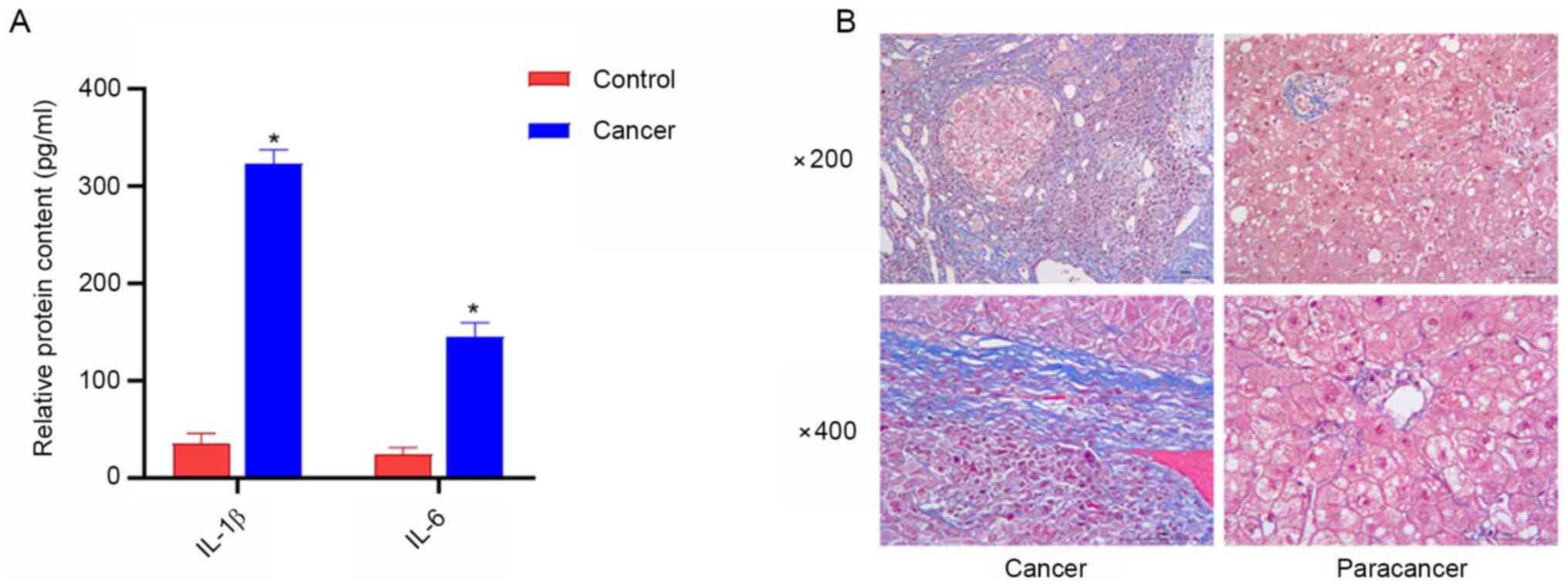|
1
|
Bray F, Ferlay J, Soerjomataram I, Siegel
RL, Torre LA and Jemal A: Global cancer statistics 2018: GLOBOCAN
estimates of incidence and mortality worldwide for 36 cancers in
185 countries. CA Cancer J Clin. 68:394–424. 2018. View Article : Google Scholar : PubMed/NCBI
|
|
2
|
McMahon BJ: Chronic hepatitis B virus
infection. Med Clin North Am. 98:39–54. 2014. View Article : Google Scholar : PubMed/NCBI
|
|
3
|
Liang CM, Chen L, Hu H, Ma HY, Gao LL, Qin
J and Zhong CP: Chemokines and their receptors play important roles
in the development of hepatocellular carcinoma. World J Hepatol.
7:1390–1402. 2015. View Article : Google Scholar : PubMed/NCBI
|
|
4
|
Tokunaga R, Zhang W, Naseem M, Puccini A,
Berger MD, Soni S, McSkane M, Baba H and Lenz HJ: CXCL9, CXCL10,
CXCL11/CXCR3 axis for immune activation-A target for novel cancer
therapy. Cancer Treat Rev. 63:40–47. 2018. View Article : Google Scholar : PubMed/NCBI
|
|
5
|
Karin N: CXCR3 ligands in cancer and
autoimmunity, chemoattraction of effector T cells, and beyond.
Front Immunol. 11:9762020. View Article : Google Scholar : PubMed/NCBI
|
|
6
|
Humblin E and Kamphorst AO: CXCR3-CXCL9:
It's all in the tumor. Immunity. 50:1347–1349. 2019. View Article : Google Scholar : PubMed/NCBI
|
|
7
|
Friedl P and Alexander S: Cancer invasion
and the microenvironment: Plasticity and reciprocity. Cell.
147:992–1009. 2011. View Article : Google Scholar : PubMed/NCBI
|
|
8
|
Zhou H, Wu J, Wang T, Zhang X and Liu D:
CXCL10/CXCR3 axis promotes the invasion of gastric cancer via
PI3K/AKT pathway-dependent MMPs production. Biomed Pharmacother.
82:479–488. 2016. View Article : Google Scholar : PubMed/NCBI
|
|
9
|
Kohlmeier JE, Cookenham T, Miller SC,
Roberts AD, Christensen JP, Thomsen AR and Woodland DL: CXCR3
directs antigen-specific effector CD4+ T cell migration
to the lung during parainfluenza virus infection. J Immunol.
183:4378–4384. 2009. View Article : Google Scholar : PubMed/NCBI
|
|
10
|
Marshall A, Celentano A, Cirillo N,
McCullough M and Porter S: Tissue-specific regulation of
CXCL9/10/11 chemokines in keratinocytes: Implications for oral
inflammatory disease. PLoS One. 12:e01728212017. View Article : Google Scholar : PubMed/NCBI
|
|
11
|
Abron JD, Singh NP, Murphy AE, Mishra MK,
Price RL, Nagarkatti M, Nagarkatti PS and Singh UP: Differential
role of CXCR3 in inflammation and colorectal cancer. Oncotarget.
9:17928–17936. 2018. View Article : Google Scholar : PubMed/NCBI
|
|
12
|
Zhang Y, Xu L and Peng M: CXCR3 is a
prognostic marker and a potential target for patients with solid
tumors: A meta-analysis. Onco Targets Ther. 11:1045–1054. 2018.
View Article : Google Scholar : PubMed/NCBI
|
|
13
|
Villarrubia VG, Alvarez-Mon M, Chirigos MA
and Herrerías JM: Hepatitis B virus (HBV) and the
inflammatory/immune response. I. The natural environment of the
antigen presentation and immunologic chaos induced by the virus.
Rev Esp Enferm Dig. 89:919–928. 1997.(In Spanish). PubMed/NCBI
|
|
14
|
Fisicaro P, Valdatta C, Boni C, Massari M,
Mori C, Zerbini A, Orlandini A, Sacchelli L, Missale G and Ferrari
C: Early kinetics of innate and adaptive immune responses during
hepatitis B virus infection. Gut. 58:974–982. 2009. View Article : Google Scholar : PubMed/NCBI
|
|
15
|
Nosratabadi R, Alavian SM, Zare-Bidaki M,
Shahrokhi VM and Arababadi MK: Innate immunity related pathogen
recognition receptors and chronic hepatitis B infection. Mol
Immunol. 90:64–73. 2017. View Article : Google Scholar : PubMed/NCBI
|
|
16
|
Gao D and Li W: Structures and recognition
modes of toll-like receptors. Proteins. 85:3–9. 2017. View Article : Google Scholar : PubMed/NCBI
|
|
17
|
Takeda K and Akira S: TLR signaling
pathways. Semin Immunol. 16:3–9. 2004. View Article : Google Scholar : PubMed/NCBI
|
|
18
|
Firmal P, Shah VK and Chattopadhyay S:
Insight Into TLR4-mediated immunomodulation in normal pregnancy and
related disorders. Front Immunol. 11:8072020. View Article : Google Scholar : PubMed/NCBI
|
|
19
|
Mylona EE, Mouktaroudi M, Crisan TO, Makri
S, Pistiki A, Georgitsi M, Savva A, Netea MG, van der Meer JW,
Giamarellos-Bourboulis EJ and Joosten LA: Enhanced interleukin-1β
production of PBMCs from patients with gout after stimulation with
toll-like receptor-2 ligands and urate crystals. Arthritis Res
Ther. 14:R1582012. View
Article : Google Scholar : PubMed/NCBI
|
|
20
|
Guo H, Jiang D, Ma D, Chang J, Dougherty
AM, Cuconati A, Block TM and Guo JT: Activation of pattern
recognition receptor-mediated innate immunity inhibits the
replication of hepatitis B virus in human hepatocyte-derived cells.
J Virol. 83:847–858. 2009. View Article : Google Scholar : PubMed/NCBI
|
|
21
|
Hösel M, Quasdorff M, Wiegmann K, Webb D,
Zedler U, Broxtermann M, Tedjokusumo R, Esser K, Arzberger S,
Kirschning CJ, et al: Not interferon, but interleukin-6 controls
early gene expression in hepatitis B virus infection. Hepatology.
50:1773–1782. 2009. View Article : Google Scholar : PubMed/NCBI
|
|
22
|
Xu Y, Köck J, Lu Y, Yang D, Lu M and Zhao
X: Suppression of hepatitis B virus replication in Tupaia
hepatocytes by tumor necrosis factor alpha of Tupaia belangeri.
Comp Immunol Microbiol Infect Dis. 34:361–368. 2011. View Article : Google Scholar : PubMed/NCBI
|
|
23
|
Gupta P and Barthwal MK: IL-1 β genesis:
The art of regulating the regulator. Cell Mol Immunol. 15:998–1000.
2018. View Article : Google Scholar : PubMed/NCBI
|
|
24
|
Mitroulis I, Kambas K and Ritis K:
Neutrophils, IL-1β, and gout: Is there a link? Semin Immunopathol.
35:501–512. 2013. View Article : Google Scholar : PubMed/NCBI
|
|
25
|
Elia G and Fallahi P: Hepatocellular
carcinoma and CXCR3 chemokines: A narrative review. Clin Ter.
168:e37–e41. 2017.PubMed/NCBI
|
|
26
|
Xu HZ, Liu YP, Guleng B and Ren JL:
Hepatitis B virus-related hepatocellular carcinoma: Pathogenic
mechanisms and novel therapeutic interventions. Gastrointest
Tumors. 1:135–145. 2014. View Article : Google Scholar : PubMed/NCBI
|
|
27
|
Zare-Bidaki M, Tsukiyama-Kohara K and
Arababadi MK: Toll-like receptor 4 and hepatitis B infection:
Molecular mechanisms and pathogenesis. Viral Immunol. 27:321–326.
2014. View Article : Google Scholar : PubMed/NCBI
|
|
28
|
Eisenhauer EA, Therasse P, Bogaerts J,
Schwartz LH, Sargent D, Ford R, Dancey J, Arbuck S, Gwyther S,
Mooney M, et al: New response evaluation criteria in solid tumours:
Revised RECIST guideline (version 1.1). Eur J Cancer. 45:228–247.
2009. View Article : Google Scholar : PubMed/NCBI
|
|
29
|
Livak KJ and Schmittgen TD: Analysis of
relative gene expression data using real-time quantitative PCR and
the 2(-Delta Delta C(T)) method. Methods. 25:402–408. 2001.
View Article : Google Scholar : PubMed/NCBI
|
|
30
|
Brenner DA, Waterboer T, Choi SK,
Lindquist JN, Stefanovic B, Burchardt E, Yamauchi M, Gillan A and
Rippe RA: New aspects of hepatic fibrosis. J Hepatol. 32 (Suppl
1):S32–S38. 2000. View Article : Google Scholar
|
|
31
|
Zhou YQ, Liu DQ, Chen SP, Sun J, Zhou XR,
Xing C, Ye DW and Tian YK: The role of CXCR3 in neurological
diseases. Curr Neuropharmacol. 17:142–150. 2019. View Article : Google Scholar : PubMed/NCBI
|
|
32
|
Li Z, Liu J, Li L, Shao S, Wu J, Bian L
and He Y: Epithelial mesenchymal transition induced by the
CXCL9/CXCR3 axis through AKT activation promotes invasion and
metastasis in tongue squamous cell carcinoma. Oncol Rep.
39:1356–1368. 2018.PubMed/NCBI
|
|
33
|
Papatheodoridis GV, Chan HL, Hansen BE,
Janssen HL and Lampertico P: Risk of hepatocellular carcinoma in
chronic hepatitis B: Assessment and modification with current
antiviral therapy. J Hepatol. 62:956–967. 2015. View Article : Google Scholar : PubMed/NCBI
|
|
34
|
Zeng Z, Li L, Chen Y, Wei H, Sun R and
Tian Z: Interferon-γ facilitates hepatic antiviral T cell retention
for the maintenance of liver-induced systemic tolerance. J Exp Med.
213:1079–1093. 2016. View Article : Google Scholar : PubMed/NCBI
|
|
35
|
Benigni G, Dimitrova P, Antonangeli F,
Sanseviero E, Milanova V, Blom A, van Lent P, Morrone S, Santoni A
and Bernardin G: CXCR3/CXCL10 axis regulates neutrophil-NK cell
cross-talk determining the severity of experimental osteoarthritis.
J Immunol. 198:2115–2124. 2017. View Article : Google Scholar : PubMed/NCBI
|
|
36
|
Masopust D, Vezys V, Marzo AL and
Lefrançois L: Preferential localization of effector memory cells in
nonlymphoid tissue. Science. 291:2413–2417. 2001. View Article : Google Scholar : PubMed/NCBI
|
|
37
|
Rébé C and Ghiringhelli F: Interleukin-1β
and cancer. Cancers (Basel). 12:17912020. View Article : Google Scholar : PubMed/NCBI
|
|
38
|
Walsh JG, Muruve DA and Power C:
Inflammasomes in the CNS. Nat Rev Neurosci. 15:84–97. 2014.
View Article : Google Scholar : PubMed/NCBI
|
|
39
|
Dinarello CA: Immunological and
inflammatory functions of the interleukin-1 family. Ann Rev
Immunol. 27:519–550. 2009. View Article : Google Scholar : PubMed/NCBI
|
|
40
|
Li AQ, Si JM, Shang Y, Gan LH, Guo L and
Zhou TH: Construction of COL1A1 short hairpin RNA vector and its
effect on cell proliferation and migration of gastric cancer cells.
Zhejiang Da Xue Xue Bao Yi Xue Ban. 39:257–263. 2010.(In Chinese).
PubMed/NCBI
|
|
41
|
Sun H: Identification of key genes
associated with gastric cancer based on DNA microarray data. Oncol
Lett. 11:525–530. 2016. View Article : Google Scholar : PubMed/NCBI
|
|
42
|
Liu S, Liao G and Li G: Regulatory effects
of COL1A1 on apoptosis induced by radiation in cervical cancer
cells. Cancer Cell Int. 17:732017. View Article : Google Scholar : PubMed/NCBI
|
|
43
|
Ambrosini G, Adida C and Altieri DC: A
novel anti-apoptosis gene, survivin, expressed in cancer and
lymphoma. Nat Med. 3:917–921. 1997. View Article : Google Scholar : PubMed/NCBI
|
|
44
|
Gunaldi M, Isiksacan N, Kocoglu H,
Okuturlar Y, Gunaldi O, Topcu TO and Karabulut M: The value of
serum survivin level in early diagnosis of cancer. J Cancer Res
Ther. 14:570–573. 2018. View Article : Google Scholar : PubMed/NCBI
|
|
45
|
Wheatley SP and Altieri DC: Survivin at a
glance. J Cell Sci. 132:jcs2238262019. View Article : Google Scholar : PubMed/NCBI
|
|
46
|
Li F, Aljahdali I and Ling X: Cancer
therapeutics using survivin BIRC5 as a target: What can we do after
over two decades of study? J Exp Clin Cancer Res. 38:3682019.
View Article : Google Scholar : PubMed/NCBI
|



















